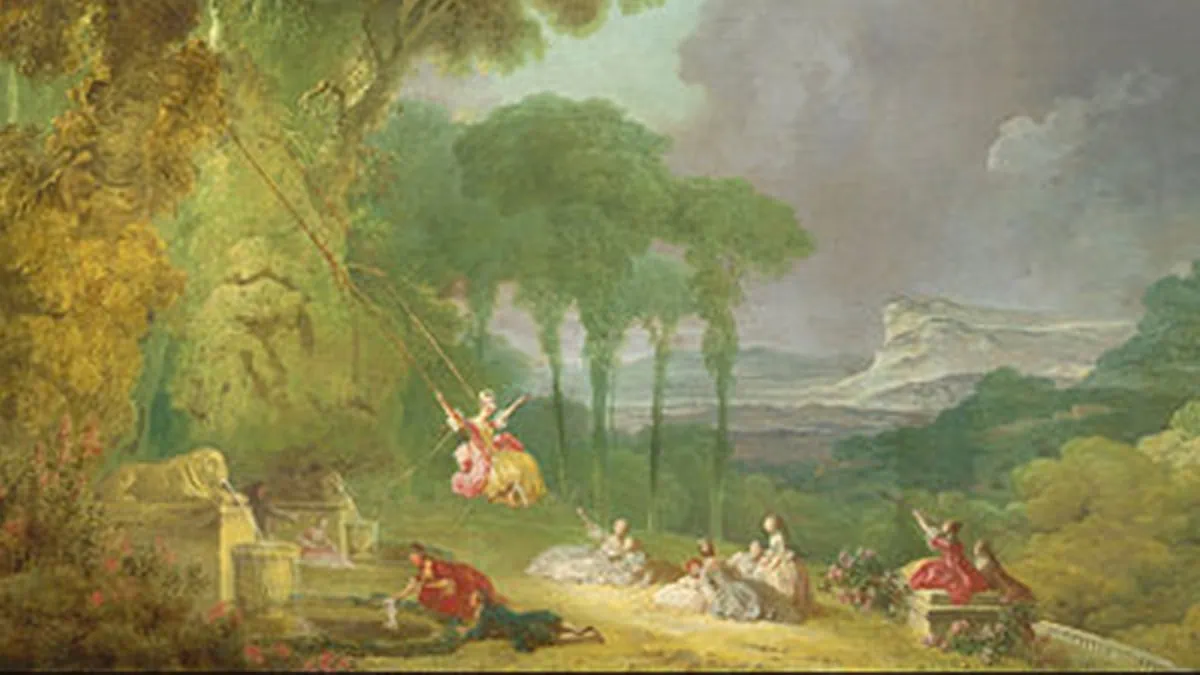Does The Swing painting ring a bell to you?
A jovial beauty in the wilderness, happily hoisted in the air on her crimson cushioned seat of the swing.
With the charm of the lovely maiden, you almost miss out on the two figures on the ground level.
Yes, there are two men, one in front of the fair maiden, gazing up under her skirt with an eager, mischievous smile.
The other man, you can spot behind, again almost hidden, but pulling on the rope of the swing for it to go to and fro!
The yearning sensual tension in the air is real!
It is a painting that hints at being an erotic art, but at the same time, makes us question a lot of things.
Like, what exactly is happening? Who is the woman, and who are the two men?
What kind of intimacy is the painting portraying?
Well, apart from being magically pleasing to the eyes, Jean-Honore Fragonard has smartly hidden secret meanings into the painting.
Yes, the erotic traces you see were definitely intentional!
So, aren’t you intrigued to know more about the artwork?
In this article, we will be understanding The Swing painting by Fragonard and look into the socio-cultural context behind it.
Apart from this, I have also curated a formal analysis of The Swing art where we look at each aspect of the painting!
Before we dig into the artwork, let us briefly look into the artist and his unique techniques!
Table of contents
Briefly Introducing Fragonard

This French painter was one of the most accomplished artists of his time!
Jean-Honoré Fragonard had actively contributed to the rococo movement and his start stood out vastly during the period.
Fragonard was not born into an artist family, but he created an artist family of his own!
His wife, Marie-Anne Gerard, was also an artist who enthusiastically worked with him and created several paintings.
Their second child and son, Alexandre-Evariste Fragonard grew up to be an artist; a painter and sculptor!
Even though Fragonard style was mostly rococo, he was also known for creating some neoclassical paintings!
He was also one of the wealthiest artists of his time, and was known for creating art for the high and elite class!
The Swing is also one such painting created for someone from his list of wealthy clientele!
Dissecting The Swing by Fragonard

Let us get into The Swing painting already!
To start with, the artwork was named L’Escarpolette in French, and was completed in the year 1768.
The famous rococo painting is currently housed in The Wallace Collection, London, United Kingdom.
Before anything, I think you need to be exposed to this fun fact about Fragonard’s painting, The Swing;
The Swing painting was not even meant for Fragonard. That is, it was initially assigned to French artist, Gabriel-Francois Doyen!
It was Baron Louis-Guillaume Baillet de Saint-Julien who commissioned the painting.
He wanted a painting of his mistress on a swing, with a bishop pushing her from behind.
Interestingly, he wanted to include him in the painting too, and wanted to be in front of her, admiring her beauty from below.
Doyen, however, was not interested and inspired with this particular idea and turned the offer down.
It was Fragonard who came forward and took up the commission, already viewing the masterpiece in his head!
And many years into the future, we know that he managed to spit out Saint-Julien’s imagination and vision onto the canvas without fail.
We also have artists like Yinka Shonibare who has created a sculpture that is wholly inspired from Jean-Fragonard’s painting The Swing.
Therefore, The Swing painting was no mere art, instead it became a source of inspiration and thought-provoking conversations.
Now that we know what the inspiration was behind The Swing art, let us get into the contextual and formal analysis!
Socio-Historical Context of The Swing Painting

Every painting is unique not just because of its artist, but also the era it belonged to.
If we look at the socio-historical context of The Swing painting, it was made during the rococo art period.
The painting encapsulates the theatrics, drama and chaos—the elements of the rococo period—which was at its peak during the time.
Like many artwork that depicted eroticism, you can see that this one was not a nude art.
In fact, at the first glance, you would associate the painting with the words— jovial, thrilled, and entertained.
This is also the rococo style surfacing in the painting.
But there are notes of desire and eroticism perfectly blended into the painting, which we will be looking into in detail soon.
Did you know that this is not the first “swing” painting that Fragonard created?
In 1775, Fragonard created a painting of a scene, in which there was a close resemblance of the lady on the swing.
There is not much research and analysis done on this second painting, which consists of a thrilled group just having a good jolly time!
Formal Analysis of The Swing Painting

Here, in this section, we will be focusing on the subject, the symbolism, the colors and textures used and the whole form of the artwork!
The Subject

The grand focus of the painting is the beautiful dame— it is impossible to get distracted from her when you look at The Swing painting.
She is dressed in the most luxurious attire that represents the elite French society.
But at the same time, you’ll notice how the attire, along with the lady, is completely taken by the wind.
The subject’s body language shifts from how women were generally portrayed in the era—coy, sophisticated and graceful.
Instead here, although we definitely see the feminine grace, her body language screams frivolousness, and mischief.
Apart from all this, she also denotes sensuality with the mischievous smile, and throwing the shoe in the air.
She carries beauty and grace with boldness. By depicting her on the swing, the artist even tried to value her freedom and beauty!
The Symbolism

Now what does this frivolous yet enchanting rococo painting of Fragonard’s The Swing depicts?
The painting is well known for carrying symbols of eroticism, but let us look into how we can spot these symbols in the painting.
For starters, how many figures do you see and where are they positioned?
Yes, there are three, because there is also a man, almost in the shadows behind, swaying the swing to and fro.
The lady here, as she is hoisted on the swing, is on the upper level of the painting, indicating control and command.
Whereas the man admiring her is on the lower level of the painting, just like he wanted to be in the painting.
But the man with the rope swinging her to and fro is standing and present in the middle level of the painting.
It is as if the man handling the rope is representing a voyeuristic act, watching them with a sly smile.
Even though it is not a scene of a sexual act, it’s definitely an act of dalliance!
The intimacy is seen through the shared gaze and the body language!
The throwing off the shoes is again a sign of welcoming sensuality.
Because during the period of the painting, exposing a woman’s ankles were considered to be scandalous!
Apart from this, we need to bring forward the male gaze in the painting.
The man’s gaze is direct, it is at the woman, and directly under her skirt—with a gaping mouth and wide ecstatic eyes!
This gaze can be seen as a sign of longing and desiring intimacy with her.
And convenient to his gaze, the woman reciprocates with him too.
Her leg is spread apart while throwing the shoe, while she locks the gaze with him with a welcoming smile!
The Hues and Shades

The Swing painting is also famous because of the beautiful pattern in the artwork that is created with colors.
As you can see, the subject stands out because of the glowing baby pink dress of hers.
Her dress is not common, but posh with a frill and floral effect to it.
Jean Fragonard has added several frills to her dress and with perfect shading, he has shown them to be frivolous and flying!
The color pattern created here is the color of her dress matching the color of the flowers on the shrubs below.
What makes the subject stand out is also how the garden, or background is painted.
Fragonard had used different shades of green and brown to show that they are in the middle of the wilderness.
The depiction of a closed area also adds to the intimacy and playfulness of the painting!
Conclusion: The Beauty of a Sweet Dalliance!

Well, if we had to decipher and analyze The Swing painting more, we could just go on and on!
Because like every art, this too has minute details by the artist that we can dwell more into.
I don’t know about you, but I definitely find it very smart of the artist to convey romance in an indirect and sly way.
Through his art he is compelling art admirers to look deeper into the painting for meaning!
You can even own a replica of this magnificent painting to keep in your hall or bedroom now;
Frequently Asked Questions
The Swing Painting is not what it seems like. It symbolizes eroticism, desire, infidelity, love and lust!
The painting was commissioned by Baron de Saint-Julien, who wanted a painting with his mistress on a swing, while he admired her from the ground below.
Yes, Fragonard painted another painting titled The Swing in 1775, which is more of a scenery that shows a group of men and women playing on the swing and having a little get-together.





